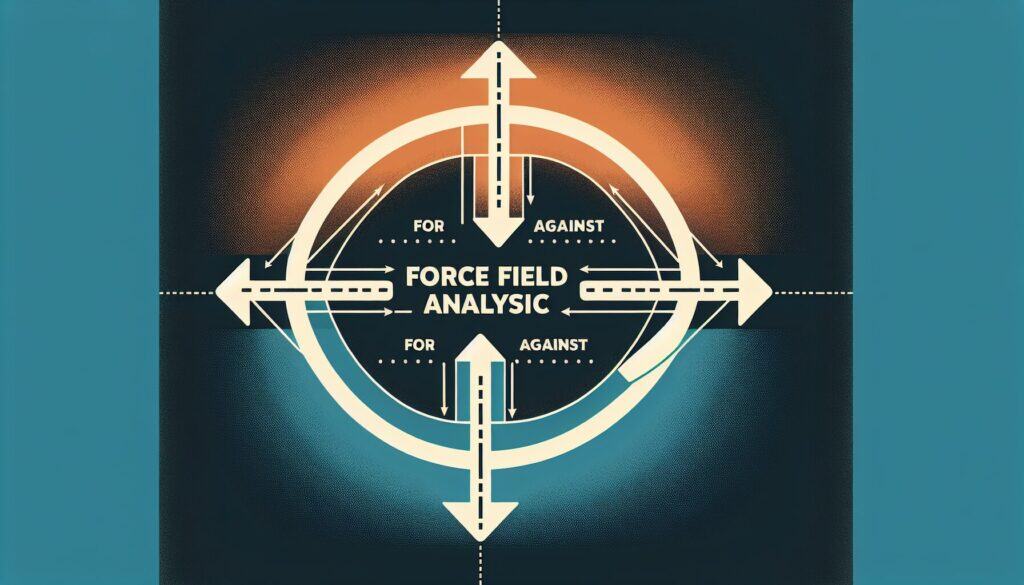To analyze the forces for and against a proposed change.
- Methodologies: Engineering, Quality
Force Field Analysis

Force Field Analysis
- Change Management, Continuous Improvement, Process Improvement, Project Management, Quality Management, Risk Management, SWOT analysis, Teamwork
Objective:
How it’s used:
- A decision-making tool that involves identifying driving forces (factors supporting the change) and restraining forces (factors opposing the change). Each force is typically assigned a score, and the analysis helps in strategizing how to strengthen driving forces and weaken restraining forces.
Pros
- Provides a clear visual summary of factors influencing a change; Helps in understanding the complexities of a change initiative; Facilitates discussion and consensus building; Aids in developing strategies to manage change effectively.
Cons
- Can be subjective in identifying and scoring forces; May oversimplify complex situations; Does not provide a definitive solution, only a framework for analysis; The process of quantifying qualitative forces can be challenging.
Categories:
- Human Resources, Problem Solving, Project Management
Best for:
- Making decisions about a proposed change by systematically identifying and evaluating the factors that will support or hinder it.
Force Field Analysis is widely applied across various sectors such as healthcare, education, manufacturing, and software development during the planning and implementation phases of projects that involve change initiatives. This methodology is typically initiated by project managers, change agents, or team leaders who seek to drive significant modifications, like the introduction of new technologies or reforms in organizational policies. It is valuable during the early stages of projects when understanding stakeholder perceptions is essential for success or when conducting impact assessments related to potential changes. Participants in these discussions often include cross-functional teams comprising engineers, designers, business analysts, and end-users, ensuring diverse perspectives are represented. By quantifying driving and restraining forces, teams can visualize the balance of power influencing the change process, which aids in facilitating open dialogue for consensus-building. For example, in an engineering context, Force Field Analysis may be employed during the design phase of a new product to weigh the benefits of cutting-edge materials against potential production challenges, enabling more informed decision-making. Furthermore, it supports strategic planning by allowing organizations to formulate actionable steps to bolster supportive factors while mitigating resistance, thus increasing the likelihood of successful implementation within a structured change management framework.
Key steps of this methodology
- Clearly define the change initiative or decision to be analyzed.
- Identify and list all driving forces supporting the change.
- Identify and list all restraining forces opposing the change.
- Assign scores to each driving and restraining force according to their impact.
- Create a visual representation of the driving and restraining forces.
- Analyze the balance of forces to understand potential outcomes.
- Develop strategies to strengthen driving forces and mitigate restraining forces.
- Implement the strategies and monitor the effects on driving and restraining forces.
Pro Tips
- Incorporate stakeholder feedback throughout the Force Field Analysis process to refine the understanding of driving and restraining forces.
- Use a scoring system that quantifies the strength of each force, enabling data-driven discussions about prioritization and strategy development.
- Regularly revisit and update the Force Field Analysis to adapt to changing internal and external factors that may influence the change initiative.
To read and compare several methodologies, we recommend the
> Extensive Methodologies Repository <
together with the 400+ other methodologies.
Your comments on this methodology or additional info are welcome on the comment section below ↓ , so as any engineering-related ideas or links.
Historical Context
1902
1907
1915
1915-11
1918
1920
1922
1902
1904
1913
1915
1916
1919-05-29
1920
1924
(if date is unknown or not relevant, e.g. "fluid mechanics", a rounded estimation of its notable emergence is provided)















Related Posts
METS to Calories Calculator
Meta-Analysis
Message Mapping
Mental Model Diagrams
Maximum Acceptable Pushing and Pulling Forces
Material Requirements Planning (MRP)